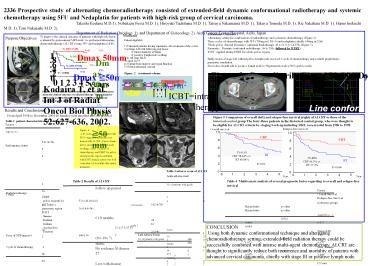PurposeObjectives
1 / 1
Title:
PurposeObjectives
Description:
D1-5 700mg/m2. NDP. D6 100-150mg/m2. Paraaortic RT. Pelvic RT ... Three cycles of chemotherapy with 5FU (700mg/m2 D1-5) and nedaplatin (chiefly 140mg/m2 D6) ... –
Number of Views:25
Avg rating:3.0/5.0
Title: PurposeObjectives
1
2336 Prospective study of alternating
chemoradiotherapy consisted of extended-field
dynamic conformational radiotherapy and systemic
chemotherapy using 5FU and Nedaplatin for
patients with high-risk group of cervical
carcinoma. Takeshi Kodaira M.D.1), Nobukazu
Fuwa M.D. 1), Hiroyuki Tachibana M.D. 1), Tatsuya
Nakamaura M.D. 1), Takuya Tomoda M.D. 1), Rie
Nakahara M.D. 1), Haruo Inokuchi M.D. 1), Toru
Nakanishi M.D. 2), Department of Radiation
Oncology 1), and Department of Gynecology 2),
Aichi Cancer Center Hospital, Aichi, Japan
Methods
Treatment Contents Alternating setting for
combication of radiaotherapy and systemeic
chemotherapy (Figure 2). Three cycles of
chemotherapy with 5FU (700mg/m2 D1-5) and
nedaplatin (chiefly 140mg/m2 D6) Whole pelvis
Biaxial Dymanic Conformal Radiotherapy
45.6-51.3Gy/24-27fx (Figure 3) Paraaortic
Dynamic conformal radiotherapy 36Gy/20fx
(followed by WPRT) ICBT applied during EBRT for
whole pelvic region. Bulky lesion of stage I-II
without pelvic lymph node received 2 cycle of
chemotehrapy and exclude prophylactic paraaortic
irradiaiton. Boost dose should add to positive
lymph node to 50(paraaortic node)-56Gy (pelvic
node)
Purpose/Objectives
To improve the clinical outcome of patients with
high risk factor evaluated by pretreatment MRI
study, we performed alternating chemoradiotherapy
(ALCRT) using 5FU and nedaplatin (NDP).
Patient eligibility 1) Untreated patients having
squamous cell carcinoma of the cervix. 2) a)Stage
I-II with following risk factor ?
tumor diameter ?50mm ? positive lymph
node swelling b) All stage III-IV 3) Aged
20-75 4) Normal bone marrow and organ function 5)
Written informed consent
5y-DFS 93.2
LN-, Dmaxlt50mm
N47
1
.8
5y-DFS 53.3
LN,Dmax lt50mm or LN-, Dmax ?50mm
N29
.6
.4
5y-DFS 25.0
.2
LN, Dmax ?50mm
Figure 3b DVH compasrison of BDCR vs box fields
techinique
Figure 3a Dose distribution of Biaxial Dynamic
Conformal Radiotherapy (BDCR)
N8
P lt 0.0001
Figure. 2 treatment scheme
0
0
1
2
3
4
5
years
Paraaortic RT
Kodaira T, et al. Int J of Radiat Oncol Biol
Physis 52627-636, 2002.
Figure. 1 Pretreatment MRI could provide
beneficial information about the clinical
outcome of radiation therapy. Tumor diameter and
lymph node swelling proved to be significant
prognostic factors in survival and tumor
control.
ICBTintracavitary brachytherapy
Line conformal Dots box field
Results and Conclusions
From April 1998 to November 2004 40 females were
enrolled into our protocol.
Figure 5 Comparison of overall (left) and
relapse-free survival (right) of ALCRT to those
of the historical-control group The forty-three
patients in the historical control group, who
were thought to be eligible for ALCRT criteria by
staging work-up including MRI, were treated from
1986 to 1998.
Table 1 patient characteristics and treatment
contents Factors Age (y.o.) 54
(34-74) Performance status 0 4 1 36 T
stage 1b 3 2a 2 2b 10 3a 3
3b 22 N stage 0 15 1 25 FIGO
stage I 3 II 11 III 21 IV 5 M
aximum Tumor size (mm) 61 (35-100)
Relapse-free survival
Overall survival
Figure. 4 A 47 years-old female patient with
FIGO stage IIIb carcinoma was treated with ALCRT.
(Dmax 86mm, pelvic and paraaortic lymph node
swelling). After 3 courses of chemotherapy and
EBRT for pelvic and paraaortic region combined
with ICBT using Ir, tumor was well controlled
63.8 months after initial treatment.
1.0
1.0
CRT
CRT
.8
.8
.6
.6
5Y-OAS CRT 78.84 vs. RT 48.84
RT
.4
.4
5Y-RFS CRT 66.5 vs. RT 37.2
RT
.2
P0.02
.2
P0.006
Table 3 adverse event of ALCRT Acute adverse
event No of patients with grade 1 2 3 4
of toxicities grade 3 Leuco
4 10 25 1 65 Neutro 4 14 14 5 47.5 Anemia 4 2
1 7 7 35 Plt 12 8 10 8 45 Liver
13 10 3 0 7.5 Renal 10 1 0 0 0 Diarrhea
14 15 9 2 27.5 Emesis 4 19 17 0 42.5 Vomiti
ng 16 25 0 0 0 Fever 0 13 1 0 2.5
0
0
5
4
2
1
0
3
5
4
2
1
0
3
Year
Year
Table 2 Results of ALCRT
Table 4 Multivariate analysis of several
prognostic factor regarding to overall and
relapse-free survival Factor Overall
Survival Relapse-free Survival (reference
group) Hazard ratio p-value Hazard
ratio p-value Age(62y.o.lt) 0.922 0.664 0.9
27 0.684 Stage (I-II) 1.10 0.600 1.073
0.673 Size(lt60mm) 1.10 0.597 1.409 0.049
LN (no) 1.12 0.597 0.857 0.336 Modal
ity (CRT) 0.639 0.031 0.534 0.0024
Follow up period 61.8 months
(8.6-106.7) Status No evidence of
disease 27 Live with disease 3 Death of
disease 10 Relapse site Local
4 Pelvic region (include
local) 5 Distant 8
Radiation therapy EBRT pelvic
region(Gy) 53.6 (41.8-64.6) OTT(days) 51(34-78
) paraaortic region 36 (14.4-54) ICBT
Source Radium 24 Iridium 16 A point
dose 23.1 (7.5-27.6) Fraction 2 (1-4) Dose
of NDP(mg/m2) 100-130 7 140 31 150 2
Cycle of chemotherapy 1 2 2 15 3 23
CONCLUSION Using both dynamic conformational
technique and alternating chemoradiothrerapy
setting, extended-field radiation therapy could
be successfully combined with intense multi-agent
chemotherapy. ALCRT are thought to significantly
reduce both recurrence and mortality of patients
with advanced cervical carcinoma, chiefly with
stage III or positive lymph node.
- Late Adverse Event
- No of patients with grade
- 0 1 2 3
- Bladder 36 2 0 2
- Rectum 29 5 6 0
- No bowel obstruction and perforation was noted.































